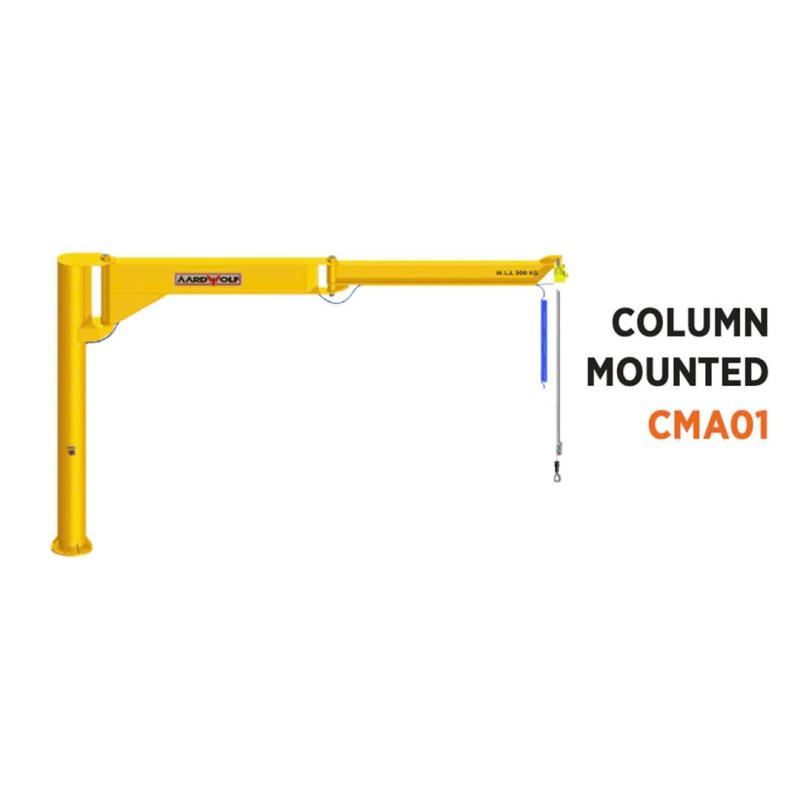



When it comes to versatile, space-efficient lifting, jib cranes often rise above other options like gantry cranes, davit arms, and fixed hoists. But how do you determine if a jib crane is right for your facility—or if another lifting solution might be a better fit?
In this comprehensive guide, we’ll compare jib cranes with other lifting systems, explore their types and configurations, and help you understand when and why they are the superior choice.
Jib cranes are pivoting arms anchored to a wall, floor, or ceiling that support a hoist for lifting loads. Their simplicity, low maintenance, and flexibility make them ideal for both standalone workstations and integrated production lines.
With configurations like the freestanding jib crane, wall mounted jib crane, ceiling mounted jib crane, articulating jib crane, and pillar jib crane, Aardwolf offers models tailored to a wide range of industrial tasks.
Learn more about Jib Cranes Trends In The Future to understand where the market is heading and how businesses are adapting.
Unlike gantry cranes or bridge cranes that require extensive floor or ceiling structures, jib cranes can be installed without major building modifications. For example, a wall-mounted jib crane offers a 180° swing with minimal space usage, ideal for compact workshops and loading areas.
In contrast, gantry cranes—though mobile—occupy more floor space and can obstruct workflows.
Articulating jib cranes stand out for their dual-arm design, allowing precise load movement around obstructions. This is particularly helpful in busy workshops or small assembly lines where traditional boom systems fall short.
Check out Aardwolf’s Articulated Jib Cranes to explore such advanced options.
Unlike davit arms and fixed hoists, which often require permanent modifications or external support beams, many jib cranes—such as the pillar-mounted models—can be bolted directly to concrete foundations or building columns.
Explore the Wall-mounted Jib Cranes in your warehouse to see how seamless integration is possible.
Gantry Cranes are ideal for moving loads over larger distances but often require an open floor layout and more operational space.
Jib Cranes excel in localized applications, like workstations, welding bays, or cutting tables.
Learn more about Jib Crane Comparisons to see side-by-side insights.
Davit Arms are common for light-duty, mobile tasks like boat handling or rooftop HVAC installation.
For repetitive industrial lifting, jib cranes offer greater stability, load capacity, and operational safety.
Overhead cranes span entire buildings and are suitable for heavy, long-distance transport.
Jib cranes are the cost-effective choice for smaller tasks requiring precision without major infrastructure.
For a deeper dive into industrial trends, visit Industrial Jib Cranes In The Future.
You should consider a jib crane when:
You have a fixed workspace (e.g., loading dock, CNC machine station).
Your lifting radius is under 6m.
You need high-frequency lifts with minimal repositioning.
You require clean floor space for foot traffic or mobile carts.
Best for outdoor use or facilities without suitable structural supports. Offers 360° rotation and customizable boom length.
Perfect for workstations where floor space is limited. Common in small fabrication shops.
Saves both floor and wall space. Ideal when ceiling structure is load-rated.
Two-arm design allows navigating tight or obstructed areas. Suitable for intricate assembly lines.
Anchored directly to the floor with a reinforced pillar. Often used in mold changing or equipment maintenance.
Not sure which to choose? Check out our guide on Applying a Jib Crane.
A fabrication shop in Victoria used Aardwolf’s Wall Mounted Jib Crane – 4m-250 to move sheet metal onto a laser bed. The installation resulted in a 30% reduction in load time and improved safety.
A Brisbane warehouse installed a custom freestanding jib crane with 5m reach for palletizing. This enabled faster cycle times and prevented workflow interruptions.
An automotive manufacturer in Melbourne integrated an articulated jib crane for engine block installation, allowing a single operator to manage tasks previously requiring two people.
Before purchasing a jib crane, evaluate:
Load capacity and lift height
Boom length and swing range
Foundation or structural mounting options
Indoor vs. outdoor usage
Integration with hoists or manipulators
Also, consider service and support. Aardwolf provides expert guidance and step-by-step installation resources to help you make the right decision.
When choosing a lifting system for your operation, jib cranes stand out for their reliability, flexibility, and cost-effectiveness. Whether you opt for a wall-mounted, freestanding, or articulating model, they outperform many alternatives in localized applications. By understanding your space, lifting needs, and future growth, you can confidently invest in a crane that improves workflow and workplace safety.
Discover more about the Jib Cranes Trends In The Future and how Aardwolf continues to lead innovation in material handling.
References
1. How to operate a Jib Cranes safely
3. Over brace jib crane wall mounted
5. Is a Jib Crane a Gantry Crane
6. Articulated Jib Crane Wall Mounted
8. Manual Counterbalance Crane
10. Over Braced Jib Crane Column Mounted
Sign up to receive the latest info on new Aardwolf products, special offers and more.
By signing up you agree to receive emails from Aardwolf with news, special offers, promotions and other information. You can unsubscribe at any time.